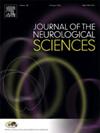The effect of cerebral collateral recycle on outcomes for patients with large ischemic infarct undergoing endovascular treatment
IF 3.6
3区 医学
Q1 CLINICAL NEUROLOGY
引用次数: 0
Abstract
Background and objectives
Although several large clinical trials have shown that endovascular treatment (EVT) is beneficial for patients with large core infarction, their outcomes were still much worse than those with mild infarction. Therefore, given the cerebral collateral recycle (CCR) as an effective prognostic marker, this study explored the relationship between CCR and clinical outcomes in patients with large ischemic infarct.
Methods
We conducted a retrospective multicenter cohort study of patients with acute ischemic stroke due to large vessel occlusion (AIS-LVO). Extensive baseline infarction was defined by ASPECTS ≤5 on admission computed tomography (CT). CCR was determined by quantifying pial arterial collaterals and venous outflow (VO) based on admission CT angiography. Patients were divided into two groups by CCR status. The primary outcomes was the favorable outcomes (90-day modified Rankin Scale score of ≤3).
Results
Among 860 AIS-LVO patients receiving EVT, 140 patients met the inclusion criteria. In multivariable binary logistic regression analysis, compared with the unfavorable CCR group, the favorable CCR group had a higher rate of favorable outcomes at 90 days (84.62 % vs 32.46 %, aOR 8.08, 95 % CI 2.13–30.62, P = .002). In a subgroup analysis, similar results were found that favorable CCR group achieved a higher proportion of 90-day mRS 0–3.
Conclusions
The favorable collateral circulation including arterial inflow combined with venous outflow in AIS-LVO patients with extensive baseline infarction is associated with better clinical outcomes. CCR status could serve as a valuable imaging biomarker for outcomes prediction.
脑侧支循环对血管内治疗大面积缺血性梗死患者预后的影响
背景和目的尽管几项大型临床试验表明血管内治疗(EVT)对大型核心梗死患者是有益的,但其结果仍远不如轻度梗死患者。因此,考虑到脑侧支循环(CCR)作为一种有效的预后指标,本研究探讨了CCR与大面积缺血性梗死患者临床结局的关系。方法对大血管闭塞性急性缺血性脑卒中患者进行回顾性多中心队列研究。入院计算机断层扫描(CT)的ASPECTS≤5定义广泛基线梗死。CCR是在入院CT血管造影的基础上通过量化动脉侧支和静脉流出量(VO)来确定的。根据CCR情况将患者分为两组。主要结局为良好结局(90天修正Rankin量表评分≤3)。结果860例接受EVT的AIS-LVO患者中,140例符合纳入标准。在多变量二元logistic回归分析中,与不良CCR组相比,良好CCR组在90天的良好转归率更高(84.62% vs 32.46%, aOR 8.08, 95% CI 2.13-30.62, P = 0.002)。在亚组分析中,类似的结果发现,良好CCR组获得90天mRS 0-3的比例更高。结论广泛基线梗死的AIS-LVO患者侧支循环良好,包括动脉流入和静脉流出,与较好的临床预后相关。CCR状态可作为预后预测的有价值的成像生物标志物。
本文章由计算机程序翻译,如有差异,请以英文原文为准。
求助全文
约1分钟内获得全文
求助全文
来源期刊

Journal of the Neurological Sciences
医学-临床神经学
CiteScore
7.60
自引率
2.30%
发文量
313
审稿时长
22 days
期刊介绍:
The Journal of the Neurological Sciences provides a medium for the prompt publication of original articles in neurology and neuroscience from around the world. JNS places special emphasis on articles that: 1) provide guidance to clinicians around the world (Best Practices, Global Neurology); 2) report cutting-edge science related to neurology (Basic and Translational Sciences); 3) educate readers about relevant and practical clinical outcomes in neurology (Outcomes Research); and 4) summarize or editorialize the current state of the literature (Reviews, Commentaries, and Editorials).
JNS accepts most types of manuscripts for consideration including original research papers, short communications, reviews, book reviews, letters to the Editor, opinions and editorials. Topics considered will be from neurology-related fields that are of interest to practicing physicians around the world. Examples include neuromuscular diseases, demyelination, atrophies, dementia, neoplasms, infections, epilepsies, disturbances of consciousness, stroke and cerebral circulation, growth and development, plasticity and intermediary metabolism.
 求助内容:
求助内容: 应助结果提醒方式:
应助结果提醒方式:


